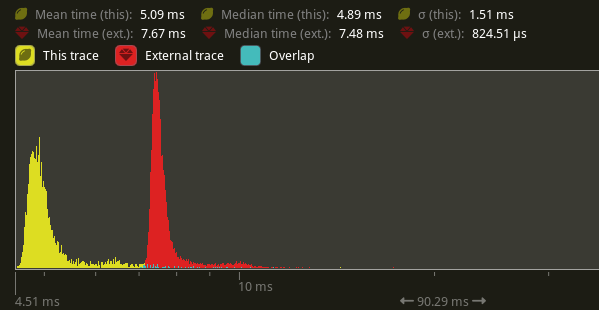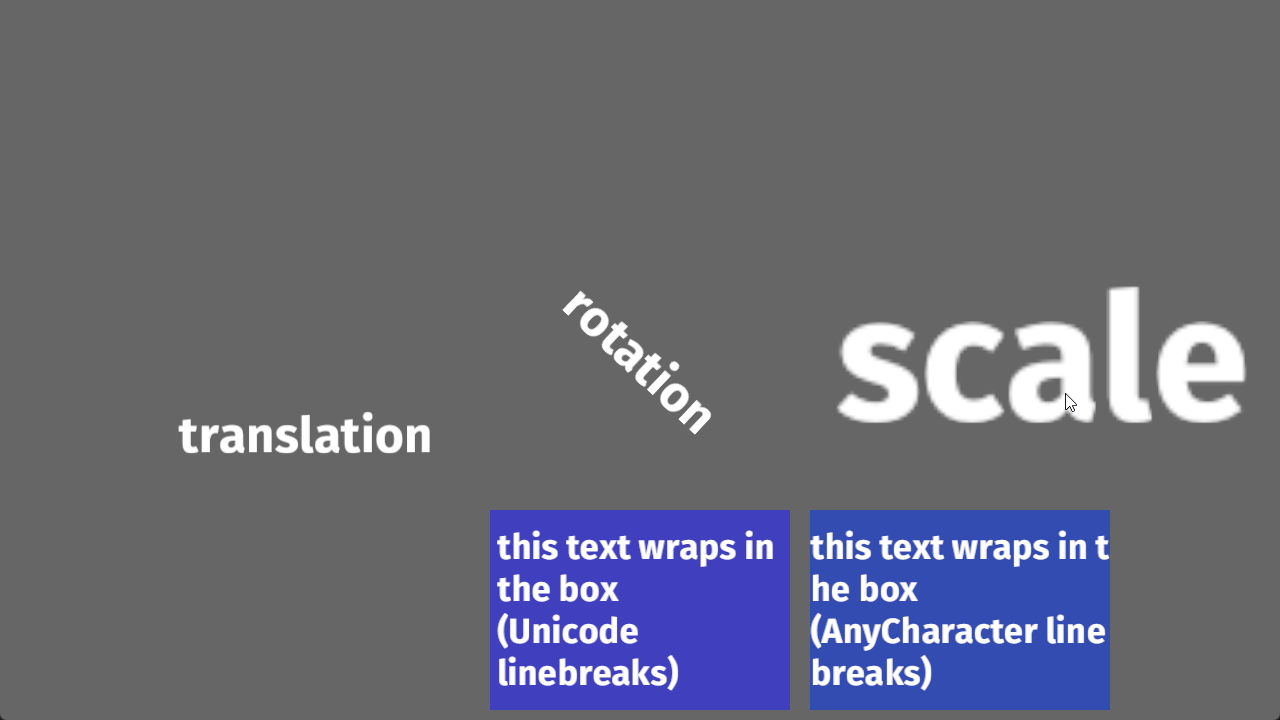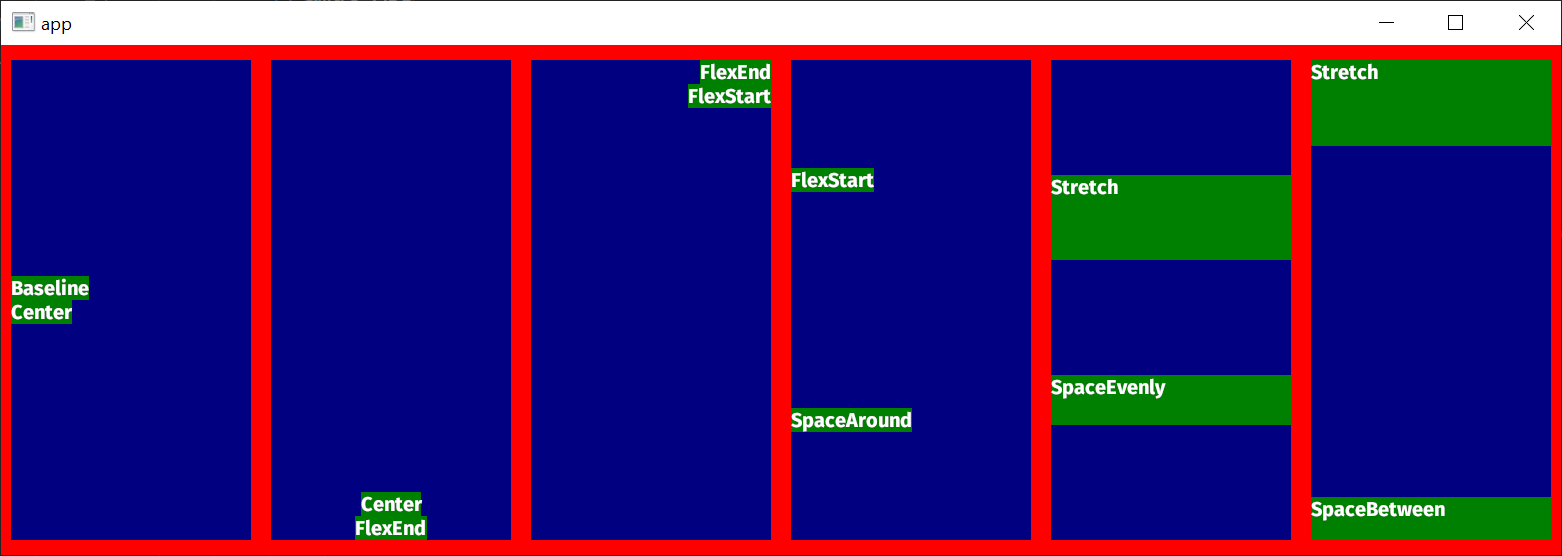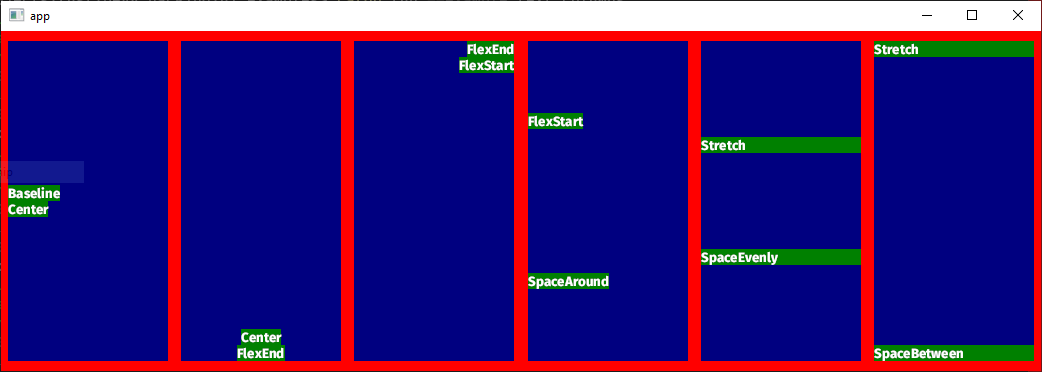# Objective
Fixes#7476. UI scale was being incorrectly ignored when a primary window exists.
## Solution
Always take into account UI scale, regardless of whether a primary window exists.
Tested locally on @forbjok 's minimal repro project https://github.com/forbjok/bevy_ui_repro with this patch, and the issue is fixed on my machine.
The `DoubleEndedIterator` impls produce incorrect results on subsequent calls to `iter()` if the iterator is only partially consumed.
The following code shows what happens
```rust
fn next_back_is_bad() {
let mut events = Events::<TestEvent>::default();
events.send(TestEvent { i: 0 });
events.send(TestEvent { i: 1 });
events.send(TestEvent { i: 2 });
let mut reader = events.get_reader();
let mut iter = reader.iter(&events);
assert_eq!(iter.next_back(), Some(&TestEvent { i: 2 }));
assert_eq!(iter.next(), Some(&TestEvent { i: 0 }));
let mut iter = reader.iter(&events);
// `i: 2` event is returned twice! The `i: 1` event is missed.
assert_eq!(iter.next(), Some(&TestEvent { i: 2 }));
assert_eq!(iter.next(), None);
}
```
I don't think this can be fixed without adding some very convoluted bookkeeping.
## Migration Guide
`ManualEventIterator` and `ManualEventIteratorWithId` are no longer `DoubleEndedIterator`s.
Co-authored-by: devil-ira <justthecooldude@gmail.com>
# Objective
Removal events are unwieldy and require some knowledge of when to put systems that need to catch events for them, it is very easy to end up missing one and end up with memory leak-ish issues where you don't clean up after yourself.
## Solution
Consolidate removals with the benefits of `Events<...>` (such as double buffering and per system ticks for reading the events) and reduce the special casing of it, ideally I was hoping to move the removals to a `Resource` in the world, but that seems a bit more rough to implement/maintain because of double mutable borrowing issues.
This doesn't go the full length of change detection esque removal detection a la https://github.com/bevyengine/rfcs/pull/44.
Just tries to make the current workflow a bit more user friendly so detecting removals isn't such a scheduling nightmare.
---
## Changelog
- RemovedComponents<T> is now backed by an `Events<Entity>` for the benefits of double buffering.
## Migration Guide
- Add a `mut` for `removed: RemovedComponents<T>` since we are now modifying an event reader internally.
- Iterating over removed components now requires `&mut removed_components` or `removed_components.iter()` instead of `&removed_components`.
# Objective
In CSS Flexbox width and height are auto by default, whereas in Bevy their default is `Size::Undefined`.
This means that, unlike in CSS, if you elide a height or width value for a node it will be given zero length (unless it has an explicitly sized child node). This has misled users into falsely assuming that they have to explicitly set a value for both height and width all the time.
relevant issue: #7120
## Solution
Change the `Size` `width` and `height` default values to `Val::Auto`
## Changelog
* Changed the `Size` `width` and `height` default values to `Val::Auto`
## Migration Guide
The default values for `Size` `width` and `height` have been changed from `Val::Undefined` to `Val::Auto`.
It's unlikely to cause any issues with existing code.
## Objective
A common easy to miss mistake is to write something like:
``` rust
Size::new(Val::Percent(100.), Val::Px(100.));
```
`UiRect` has the `left`, `right`, `all`, `vertical`, etc constructor functions, `Size` is used a lot more frequently but lacks anything similar.
## Solution
Implement `all`, `width` and `height` functions for `Size`.
## Changelog
* Added `all`, `width` and `height` functions to `Size`.
# Problem
The field is called `background_color` but it is also used to hold the colors of text glyphs and images.
It's mildly confusing and longer to type than just `color`.
## Solution
Rename `background_color` to `color`.
## Changelog
* Renamed the `background_color` field of `ExtractedUiNode` to `color`.
## Migration Guide
* The `background_color` field of `ExtractedUiNode` is now named `color`.
## Objective
Remove `QueuedText`.
`QueuedText` isn't useful. It's exposed in the `bevy_ui` public interface but can't be used for anything because its `entities` field is private.
## Solution
Remove the `QueuedText` struct and use a `Local<Vec<Entity>` in its place.
## Changelog
* Removed `QueuedText`
# Objective
In simple cases we might want to derive the `ExtractComponent` trait.
This adds symmetry to the existing `ExtractResource` derive.
## Solution
Add an implementation of `#[derive(ExtractComponent)]`.
The implementation is adapted from the existing `ExtractResource` derive macro.
Additionally, there is an attribute called `extract_component_filter`. This allows specifying a query filter type used when extracting.
If not specified, no filter (equal to `()`) is used.
So:
```rust
#[derive(Component, Clone, ExtractComponent)]
#[extract_component_filter(With<Fuel>)]
pub struct Car {
pub wheels: usize,
}
```
would expand to (a bit cleaned up here):
```rust
impl ExtractComponent for Car
{
type Query = &'static Self;
type Filter = With<Fuel>;
type Out = Self;
fn extract_component(item: QueryItem<'_, Self::Query>) -> Option<Self::Out> {
Some(item.clone())
}
}
```
---
## Changelog
- Added the ability to `#[derive(ExtractComponent)]` with an optional filter.
Co-authored-by: Robert Swain <robert.swain@gmail.com>
# Objective
Implements cascaded shadow maps for directional lights, which produces better quality shadows without needing excessively large shadow maps.
Fixes#3629
Before

After

## Solution
Rather than rendering a single shadow map for directional light, the view frustum is divided into a series of cascades, each of which gets its own shadow map. The correct cascade is then sampled for shadow determination.
---
## Changelog
Directional lights now use cascaded shadow maps for improved shadow quality.
## Migration Guide
You no longer have to manually specify a `shadow_projection` for a directional light, and these settings should be removed. If customization of how cascaded shadow maps work is desired, modify the `CascadeShadowConfig` component instead.
# Problem
The `upsert_leaf` method creates a new `MeasureFunc` and, if required, a new leaf node, but then it only adds the new `MeasureFunc` to existing leaf nodes.
## Solution
Add the `MeasureFunc` to new leaf nodes as well.
# Objective
Speed up `prepare_uinodes`. The color `[f32; 4]` is being computed separately for every vertex in the UI, even though the color is the same for all 6 verticies.
## Solution
Avoid recomputing the color and cache it for all 6 verticies.
## Performance
On `many_buttons`, this shaved off 33% of the time in `prepare_uinodes` (7.67ms -> 5.09ms) on my local machine.

# Objective
Currently, Text always uses the default linebreaking behaviour in glyph_brush_layout `BuiltInLineBreaker::Unicode` which breaks lines at word boundaries. However, glyph_brush_layout also supports breaking lines at any character by setting the linebreaker to `BuiltInLineBreaker::AnyChar`. Having text wrap character-by-character instead of at word boundaries is desirable in some cases - consider that consoles/terminals usually wrap this way.
As a side note, the default Unicode linebreaker does not seem to handle emergency cases, where there is no word boundary on a line to break at. In that case, the text runs out of bounds. Issue #1867 shows an example of this.
## Solution
Basically just copies how TextAlignment is exposed, but for a new enum TextLineBreakBehaviour.
This PR exposes glyph_brush_layout's two simple linebreaking options (Unicode, AnyChar) to users of Text via the enum TextLineBreakBehaviour (which just translates those 2 aforementioned options), plus a method 'with_linebreak_behaviour' on Text and TextBundle.
## Changelog
Added `Text::with_linebreak_behaviour`
Added `TextBundle::with_linebreak_behaviour`
`TextPipeline::queue_text` and `GlyphBrush::compute_glyphs` now need a TextLineBreakBehaviour argument, in order to pass through the new field.
Modified the `text2d` example to show both linebreaking behaviours.
## Example
Here's what the modified example looks like

# Objective
- Fixes#7288
- Do not expose access directly to cursor position as it is the physical position, ignoring scale
## Solution
- Make cursor position private
- Expose getter/setter on the window to have access to the scale
## Problem
`extract_uinodes` checks if an image is loaded for nodes without images
## Solution
Move the image loading skip check so that it is only performed for nodes with a `UiImage` component.
# Objective
Fix https://github.com/bevyengine/bevy/issues/4530
- Make it easier to open/close/modify windows by setting them up as `Entity`s with a `Window` component.
- Make multiple windows very simple to set up. (just add a `Window` component to an entity and it should open)
## Solution
- Move all properties of window descriptor to ~components~ a component.
- Replace `WindowId` with `Entity`.
- ~Use change detection for components to update backend rather than events/commands. (The `CursorMoved`/`WindowResized`/... events are kept for user convenience.~
Check each field individually to see what we need to update, events are still kept for user convenience.
---
## Changelog
- `WindowDescriptor` renamed to `Window`.
- Width/height consolidated into a `WindowResolution` component.
- Requesting maximization/minimization is done on the [`Window::state`] field.
- `WindowId` is now `Entity`.
## Migration Guide
- Replace `WindowDescriptor` with `Window`.
- Change `width` and `height` fields in a `WindowResolution`, either by doing
```rust
WindowResolution::new(width, height) // Explicitly
// or using From<_> for tuples for convenience
(1920., 1080.).into()
```
- Replace any `WindowCommand` code to just modify the `Window`'s fields directly and creating/closing windows is now by spawning/despawning an entity with a `Window` component like so:
```rust
let window = commands.spawn(Window { ... }).id(); // open window
commands.entity(window).despawn(); // close window
```
## Unresolved
- ~How do we tell when a window is minimized by a user?~
~Currently using the `Resize(0, 0)` as an indicator of minimization.~
No longer attempting to tell given how finnicky this was across platforms, now the user can only request that a window be maximized/minimized.
## Future work
- Move `exit_on_close` functionality out from windowing and into app(?)
- https://github.com/bevyengine/bevy/issues/5621
- https://github.com/bevyengine/bevy/issues/7099
- https://github.com/bevyengine/bevy/issues/7098
Co-authored-by: Carter Anderson <mcanders1@gmail.com>
# Objective
Add useful information about cursor position relative to a UI node. Fixes#7079.
## Solution
- Added a new `RelativeCursorPosition` component
---
## Changelog
- Added
- `RelativeCursorPosition`
- an example showcasing the new component
Co-authored-by: Dawid Piotrowski <41804418+Pietrek14@users.noreply.github.com>
# Objective
- Allow rendering queue systems to use a `Res<PipelineCache>` even for queueing up new rendering pipelines. This is part of unblocking parallel execution queue systems.
## Solution
- Make `PipelineCache` internally mutable w.r.t to queueing new pipelines. Pipelines are no longer immediately updated into the cache state, but rather queued into a Vec. The Vec of pending new pipelines is then later processed at the same time we actually create the queued pipelines on the GPU device.
---
## Changelog
`PipelineCache` no longer requires mutable access in order to queue render / compute pipelines.
## Migration Guide
* Most usages of `resource_mut::<PipelineCache>` and `ResMut<PipelineCache>` can be changed to `resource::<PipelineCache>` and `Res<PipelineCache>` as long as they don't use any methods requiring mutability - the only public method requiring it is `process_queue`.
# Objective
- While building UI, it makes more sense for most nodes to have a `FocusPolicy` of `Pass`, so that user interaction can correctly bubble
- Only `ButtonBundle` blocks by default
This change means that for someone adding children to a button, it's not needed to change the focus policy of those children to `Pass` for the button to continue to work.
---
## Changelog
- `FocusPolicy` default has changed from `FocusPolicy::Block` to `FocusPolicy::Pass`
## Migration Guide
- `FocusPolicy` default has changed from `FocusPolicy::Block` to `FocusPolicy::Pass`
# Objective
- Fixes#7066
## Solution
- Split the ChangeDetection trait into ChangeDetection and ChangeDetectionMut
- Added Ref as equivalent to &T with change detection
---
## Changelog
- Support for Ref which allow inspecting change detection flags in an immutable way
## Migration Guide
- While bevy prelude includes both ChangeDetection and ChangeDetectionMut any code explicitly referencing ChangeDetection might need to be updated to ChangeDetectionMut or both. Specifically any reading logic requires ChangeDetection while writes requires ChangeDetectionMut.
use bevy_ecs::change_detection::DetectChanges -> use bevy_ecs::change_detection::{DetectChanges, DetectChangesMut}
- Previously Res had methods to access change detection `is_changed` and `is_added` those methods have been moved to the `DetectChanges` trait. If you are including bevy prelude you will have access to these types otherwise you will need to `use bevy_ecs::change_detection::DetectChanges` to continue using them.
# Objective
Speed up the render phase for rendering.
## Solution
- Follow up #6988 and make the internals of atomic IDs `NonZeroU32`. This niches the `Option`s of the IDs in draw state, which reduces the size and branching behavior when evaluating for equality.
- Require `&RenderDevice` to get the device's `Limits` when initializing a `TrackedRenderPass` to preallocate the bind groups and vertex buffer state in `DrawState`, this removes the branch on needing to resize those `Vec`s.
## Performance
This produces a similar speed up akin to that of #6885. This shows an approximate 6% speed up in `main_opaque_pass_3d` on `many_foxes` (408.79 us -> 388us). This should be orthogonal to the gains seen there.

---
## Changelog
Added: `RenderContext::begin_tracked_render_pass`.
Changed: `TrackedRenderPass` now requires a `&RenderDevice` on construction.
Removed: `bevy_render::render_phase::DrawState`. It was not usable in any form outside of `bevy_render`.
## Migration Guide
TODO
# Objective
- Fixes#5529
## Solution
- Add assosciated constants named DEFAULT to as many types as possible
- Add const to as many methods in bevy_ui as possible
I have not applied the same treatment to the bundles in bevy_ui as it would require going into other bevy crates to implement const defaults for structs in bevy_text or relies on UiImage which calls HandleUntyped.typed() which isn't const safe.
Alternatively the defaults could relatively easily be turned into a macro to regain some of the readability and conciseness at the cost of explicitness.
Such a macro that partially implements this exists as a crate here: [const-default](https://docs.rs/const-default/latest/const_default/derive.ConstDefault.html) but does not support enums.
Let me know if there's anything I've missed or if I should push further into other crates.
Co-authored-by: Carter Anderson <mcanders1@gmail.com>
# Objective
Speed up the render phase of rendering. Simplify the trait structure for render commands.
## Solution
- Merge `EntityPhaseItem` into `PhaseItem` (`EntityPhaseItem::entity` -> `PhaseItem::entity`)
- Merge `EntityRenderCommand` into `RenderCommand`.
- Add two associated types to `RenderCommand`: `RenderCommand::ViewWorldQuery` and `RenderCommand::WorldQuery`.
- Use the new associated types to construct two `QueryStates`s for `RenderCommandState`.
- Hoist any `SQuery<T>` fetches in `EntityRenderCommand`s into the aformentioned two queries. Batch fetch them all at once.
## Performance
`main_opaque_pass_3d` is slightly faster on `many_foxes` (427.52us -> 401.15us)

The shadow pass node is also slightly faster (344.52 -> 338.24us)

## Future Work
- Can we hoist the view level queries out of the core loop?
---
## Changelog
Added: `PhaseItem::entity`
Added: `RenderCommand::ViewWorldQuery` associated type.
Added: `RenderCommand::ItemorldQuery` associated type.
Added: `Draw<T>::prepare` optional trait function.
Removed: `EntityPhaseItem` trait
## Migration Guide
TODO
# Objective
- The recently merged PR #7013 does not allow multiple `RenderPhase`s to share the same `RenderPass`.
- Due to the introduced overhead we want to minimize the number of `RenderPass`es recorded during each frame.
## Solution
- Take a constructed `TrackedRenderPass` instead of a `RenderPassDiscriptor` as a parameter to the `RenderPhase::render` method.
---
## Changelog
To enable multiple `RenderPhases` to share the same `TrackedRenderPass`,
the `RenderPhase::render` signature has changed.
```rust
pub fn render<'w>(
&self,
render_pass: &mut TrackedRenderPass<'w>,
world: &'w World,
view: Entity)
```
Co-authored-by: Kurt Kühnert <51823519+kurtkuehnert@users.noreply.github.com>
# Objective
All `RenderPhases` follow the same render procedure.
The same code is duplicated multiple times across the codebase.
## Solution
I simply extracted this code into a method on the `RenderPhase`.
This avoids code duplication and makes setting up new `RenderPhases` easier.
---
## Changelog
### Changed
You can now set up the rendering code of a `RenderPhase` directly using the `RenderPhase::render` method, instead of implementing it manually in your render graph node.
# Objective
Upgrade to Taffy 0.2
## Solution
Do it
## Changelog
Upgraded to Taffy 0.2, improving UI layout performance significantly and adding the flexbox `gap` property and `AlignContent::SpaceEvenly`.
## Notes
`many_buttons` is 8% faster! speed improvements for more highly nested UIs will be much more dramatic. Great work, Team Taffy.
The Camera link in the UiCameraConfig was not rendered properly by the documentation.
# Objective
- In the UiCameraConfig page (https://docs.rs/bevy/latest/bevy/prelude/struct.UiCameraConfig.html), a link to the Camera page (https://docs.rs/bevy/latest/bevy/render/camera/struct.Camera.html) is broken.
## Solution
- It seems that when using URL fragment specifiers, backtick should not be used. It might be an issue of rust itself. Replacing the URL fragment specifier `[`Camera`]: bevy_render:📷:Camera` with `[Camera]: bevy_render:📷:Camera` solves this.
## Objective
Bevy UI uses a `MeasureFunc` that preserves the aspect ratio of text, not just images. This means that the extent of flex-items containing text may be calculated incorrectly depending on the ratio of the text size compared to the size of its containing node.
Fixes#6748
Related to #6724
with Bevy 0.9:

with this PR (accurately matching the behavior of Flexbox):

## Solution
Only perform the aspect ratio calculations if the uinode contains an image.
## Changelog
* Added a field `preserve_aspect_ratio` to `CalculatedSize`
* The `MeasureFunc` only preserves the aspect ratio when `preserve_aspect_ratio` is true.
* `update_image_calculated_size_system` sets `preserve_aspect_ratio` to true for nodes with images.
# Objective
Change detection can be spuriously triggered by setting a field to the same value as before. As a result, a common pattern is to write:
```rust
if *foo != value {
*foo = value;
}
```
This is confusing to read, and heavy on boilerplate.
Adopted from #5373, but untangled and rebased to current `bevy/main`.
## Solution
1. Add a method to the `DetectChanges` trait that implements this boilerplate when the appropriate trait bounds are met.
2. Document this minor footgun, and point users to it.
## Changelog
* added the `set_if_neq` method to avoid triggering change detection when the new and previous values are equal. This will work on both components and resources.
## Migration Guide
If you are manually checking if a component or resource's value is equal to its new value before setting it to avoid triggering change detection, migrate to the clearer and more convenient `set_if_neq` method.
## Context
Related to #2363 as it avoids triggering change detection, but not a complete solution (as it still requires triggering it when real changes are made).
Co-authored-by: Zoey <Dessix@Dessix.net>
# Objective
- Every usage of `DrawFunctionsInternals::get_id()` was followed by a `.unwrap()`. which just adds boilerplate.
## Solution
- Introduce a fallible version of `DrawFunctionsInternals::get_id()` and use it where possible.
- I also took the opportunity to improve the error message a little in the case where it fails.
---
## Changelog
- Added `DrawFunctionsInternals::id()`
# Objective
Fixes#6642
In a way that doesn't create any breaking changes, as a possible way to fix the above in a patch release.
## Solution
Don't actually remove font atlases when `max_font_atlases` is exceeded. Add a warning instead.
Keep `TextError::ExceedMaxTextAtlases` and `TextSettings` as-is so we don't break anything.
This is a bit of a cop-out, but the problems revealed by #6642 seem very challenging to fix properly.
Maybe follow up later with something more like https://github.com/rparrett/bevy/commits/remove-max-font-atlases later, if this is the direction we want to go.
## Note
See previous attempt at a "simple fix" that only solved some of the issues: #6666
# Objective
`add_node_edge` and `add_slot_edge` are fallible methods, but are always used with `.unwrap()`.
`input_node` is often unwrapped as well.
This points to having an infallible behaviour as default, with an alternative fallible variant if needed.
Improves readability and ergonomics.
## Solution
- Change `add_node_edge` and `add_slot_edge` to panic on error.
- Change `input_node` to panic on `None`.
- Add `try_add_node_edge` and `try_add_slot_edge` in case fallible methods are needed.
- Add `get_input_node` to still be able to get an `Option`.
---
## Changelog
### Added
- `try_add_node_edge`
- `try_add_slot_edge`
- `get_input_node`
### Changed
- `add_node_edge` is now infallible (panics on error)
- `add_slot_edge` is now infallible (panics on error)
- `input_node` now panics on `None`
## Migration Guide
Remove `.unwrap()` from `add_node_edge` and `add_slot_edge`.
For cases where the error was handled, use `try_add_node_edge` and `try_add_slot_edge` instead.
Remove `.unwrap()` from `input_node`.
For cases where the option was handled, use `get_input_node` instead.
Co-authored-by: Torstein Grindvik <52322338+torsteingrindvik@users.noreply.github.com>
# Objective
Allow more use cases where the user may benefit from both `ExtractComponentPlugin` _and_ `UniformComponentPlugin`.
## Solution
Add an associated type to `ExtractComponent` in order to allow specifying the output component (or bundle).
Make `extract_component` return an `Option<_>` such that components can be extracted only when needed.
What problem does this solve?
`ExtractComponentPlugin` allows extracting components, but currently the output type is the same as the input.
This means that use cases such as having a settings struct which turns into a uniform is awkward.
For example we might have:
```rust
struct MyStruct {
enabled: bool,
val: f32
}
struct MyStructUniform {
val: f32
}
```
With the new approach, we can extract `MyStruct` only when it is enabled, and turn it into its related uniform.
This chains well with `UniformComponentPlugin`.
The user may then:
```rust
app.add_plugin(ExtractComponentPlugin::<MyStruct>::default());
app.add_plugin(UniformComponentPlugin::<MyStructUniform>::default());
```
This then saves the user a fair amount of boilerplate.
## Changelog
### Changed
- `ExtractComponent` can specify output type, and outputting is optional.
Co-authored-by: Torstein Grindvik <52322338+torsteingrindvik@users.noreply.github.com>
# Objective
Delete `ImageMode`. It doesn't do anything except mislead people into thinking it controls the aspect ratio of images somehow.
Fixes#3933 and #6637
## Solution
Delete `ImageMode`
## Changelog
Removes the `ImageMode` enum.
Removes the `image_mode` field from `ImageBundle`
Removes the `With<ImageMode>` query filter from `image_node_system`
Renames `image_node_system` to` update_image_calculated_size_system`
# Objective
Fixes#6594
## Solution
- `New` function for `Size` is now a `const` function :)
## Changelog
- `New` function for `Size` is now a `const` function
## Migration Guide
- Nothing has been changed
# Objective
Fixes #3225, Allow for flippable UI Images
## Solution
Add flip_x and flip_y fields to UiImage, and swap the UV coordinates accordingly in ui_prepare_nodes.
## Changelog
* Changes UiImage to a struct with texture, flip_x, and flip_y fields.
* Adds flip_x and flip_y fields to ExtractedUiNode.
* Changes extract_uinodes to extract the flip_x and flip_y values from UiImage.
* Changes prepare_uinodes to swap the UV coordinates as required.
* Changes UiImage derefs to texture field accesses.
This reverts commit 8429b6d6ca as discussed in #6522.
I tested that the game_menu example works as it should.
Co-authored-by: devil-ira <justthecooldude@gmail.com>
# Objective
`NodeBundle` contains an `image` field, which can be misleading, because if you do supply an image there, nothing will be shown to screen. You need to use an `ImageBundle` instead.
## Solution
* `image` (`UiImage`) field is removed from `NodeBundle`,
* extraction stage queries now make an optional query for `UiImage`, if one is not found, use the image handle that is used as a default by `UiImage`: c019a60b39/crates/bevy_ui/src/ui_node.rs (L464)
* touching up docs for `NodeBundle` to help guide what `NodeBundle` should be used for
* renamed `entity.rs` to `node_bundle.rs` as that gives more of a hint regarding the module's purpose
* separating `camera_config` stuff from the pre-made UI node bundles so that `node_bundle.rs` makes more sense as a module name.
# Objective
Bevy UI (and third party plugins) currently have no good way to position themselves after all post processing effects. They currently use the tonemapping node, but this is not adequate if there is anything after tonemapping (such as FXAA).
## Solution
Add a logical `END_MAIN_PASS_POST_PROCESSING` RenderGraph node that main pass post processing effects position themselves before, and things like UIs can position themselves after.
# Objective
The UI pass in HDR breaks currently because the color attachment format does not match the HDR ViewTarget.
## Solution
Specialize the UI pipeline on "hdr-ness" and select the appropriate format (like we do in the other built in pipelines).
# Objective
Replace `WorldQueryGats` trait with actual gats
## Solution
Replace `WorldQueryGats` trait with actual gats
---
## Changelog
- Replaced `WorldQueryGats` trait with actual gats
## Migration Guide
- Replace usage of `WorldQueryGats` assoc types with the actual gats on `WorldQuery` trait